Drum Machine and Sampler Museum
by Bobby Nathan
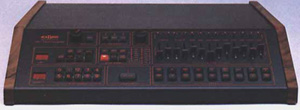 The Linn LM-1 |
sampling was my life! It all started when we bought one of the first Linn Drums (LM-1) for our studio, Unique Recording. Back then, when anyone heard the Linn Drum, they were blown away. It brought us business. Everyone wanted to experience the new sounds and the new technology. |
Before the Linn Drum, making dance (disco) records
required making a “Drum Loop”.
Oh yes, we had drum loops back in 1978!
Drum loops were made on 1/4″ 2 track tape recorders.
First we would simultaneously record the kick
drum to the left channel and snare to the right.
We would edit the tape to be two, four or eight
bars. Then splice the tape into a loop.
We would thread it onto the 2 track and one of
us would hold the tape
using our finger as a guide roller or set up
a mic stand to be the guide roller
and play the loop to tape for 3- 6 minutes.
|
It had kick and snare, toms, congas, bongos, wood block, clave, high hat and cymbals. The sounds of real drums were sampled into EPROMs that were located inside the unit. Then when Roger Linn introduced the newer Linndrum he offered a service to burn your own sounds into EPROMs on a custom basis. |
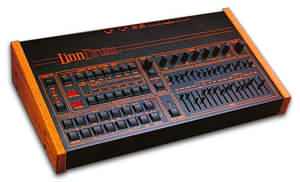 The Linndrum |
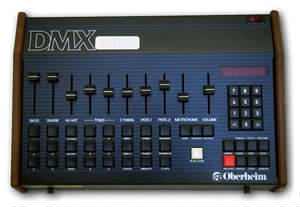 Oberheim DMX |
then Roland’s 808 drum machines. Oberheim later offered the ability to burn custom EPROMs. |
|
tape provision, it was hard to sync to tape! There were no rules. We made them up as we went along. I was constantly searching for a way to conquer this. |
 Roland TR-808 |
 The Movement Drum Computer |
at the end of the 1970s – those that embraced the drum machine and those that fought it. I was totally for the drum machine. The Movement Drum Computer (the orange beast on the left) was made in England. It was used by Thomas Dolby, The Eurhymics and the Thompson Twins. It is a very rare unit and we still have it! It can play it’s LinnDrum sampled type sounds and Simmons analog sounds at the same time.
|
|
group called PolyRock that we saw at Harrah’s. They were a live band with synthesizers and live drums. Phillip Glass came aboard and finished up what I had started. I also recorded Bill Laswell’s debut single with Material. Bill eventually produced Herbie Hancock’s “Rockit”, a totally drum machined Lp. Unique purchased the Simmons SDS-5 Electronic drum kit |
 Simmons Pads |
 Arthur Baker |
John Robie and Tom Silverman and together with engineers Jay Burnett and Bob Rosa, they created what is the modern day Hip Hop. Tom Silverman formed the first independent record label Tommy Boy Records. This began the 12″ single era. Arthur also recored and mixed Planet Patrol’s “Planet Rock”, “Looking For A Perfect Beat”, “Funky Soul Makosa”, Freeze “AEIOU”, and with producer Maurice Starr co-porduced New Edition’s “Candy Girl” and “Pop Corn Love” and later the soundtrack to “Beat Street”. All at Unique Recording Studios! |
The magic of the Drum Machine era was that each
machine made music feel different.
It had to do with the way each machine quantized
(time corrected ) the notes
A roland TR-808 ‘s 2 bar pattern felt completely
different
from the same one programmed into a Lindrumm
|
only way to share knowledge was at the trade shows. At the January 1982 NAMM show I met Dan Garfield and ordered the save all – The Doctor Click. This box printed a 1/4 note click on the tape and sync’d drum machines to it.. It allowed the Linndrum, DMX, DSX and the impossible Roland 808 not only to sync to tape but to each other ! Arthur Baker and John Robie where searching for a way to use the 808 kick with Linndrum and DMX. The Doctor Click was it. And the magic happened at Unique Recording. |
 The Dr.Click |
 The Emulator |
sampler. This $35k machine was all I had to see. But, we couldn’t afford it! So we bought the Emulator. I was hooked. |
I began immediately sampling everything!
I went through all the sound EFX records, orchestra
hits, cartoons, television shows, movies
I was never satisfied. So I bought a Nagra
and went out to get my own sounds at the junkyard.
I banged on fenders, brake drums, steel, brass,
aluminum, street signs, street lamps.
You name it, recorded it and sampled it.
I had thousands of 5 and 1/4″ floppy disks full
of emulator samples
that were tuned to A440 and were ready to be
used musically.
I rented orchestra instruments from Carroll Music
and SIR and sampled away.
|
and they flipped over my sounds. They bought my samples I hosted a 1983 Fall AES show for them at Unique Recording Studios. It was for the elite in the record business. All I can remember is watching Todd Rundgren’s face as I brought them all to their knees with my samples of James Brown’s screams! I had fun showing them to James Brown in 1986 during the recording of the Rocky V sound track “Living in America” and James Brown’s albun “Gravity” both produced by Dan hartman at Unique Recording Studios. |
 |
|
Brown’s screams for demonstration purposes only. I never advocated putting his screams on record nor did I ever sell the samples for monetary gain. |
 The Emulator II |
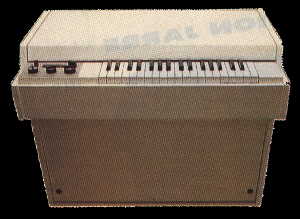 The Beatles used the mellotron on Strawberry Fields |
and The Beatles with Sir George Martin, everyone was looking for new sounds. I was on a mission recording and sampling new sounds for “Hip Hop” and “New Wave” and new music in general. My samples were everywhere. I wasn’t greedy. It wasn’t about money. I was just having a party. And the party attracted The Cars, David Bryne, Patrick Moraz and Vangelis. |
|
for Yamaha’s new instrument the DX7. Between sampling and the DX7 my head was spinning. Everyone came by just to hear and check the DX7 out. But the DX7 had something new, it was called MIDI. |
 |
|
else. We hired Jim (JL) Cooper to add midi onto our Arp 2600, our Mini Moog, our OBXa, and our Oberheim modular 8 voice. We added the Prophet 5 and the Voyetra 8.. |
 Arp 2600 |
 The Mini Moog |
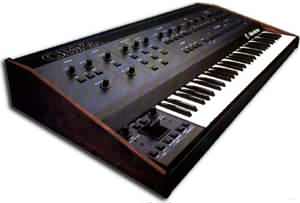 Oberfheim OBXa |
 Oberheim Modular 8 Voive |
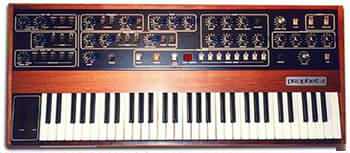 The Prophet 5 |
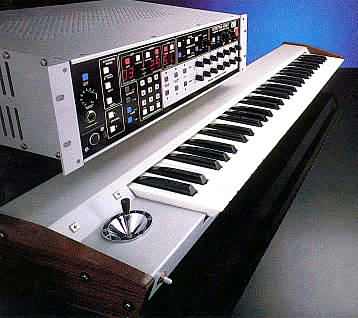 The Voyetra 8 |
was doing a remake of “Frankenstein” for Tommy Boy Records with the Voyetra. He tried to replace the Arp 2600’s sound with a programmable synth, but in the end ripped the solo off in just one pass with the 2600! |
|
was recording Cheap Trick at the time in studio B with Chris Lord Alge engineering. We set up all three of our DX7s, and everything else that had Midi on it. There were synthesizers all over the control room – on stands, the floors, everywhere. We called it “The wall of Sound”. |
 The MemoryMoog |
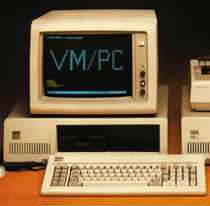 |
We ran Voyetra Sequencer Plus and Personal Composer and the DX7 librarian software |
|
to our Yamaha Acoustic pianos. McCoy Tyner was recording his Lp. with us at that time. Engineer Frank Heller and I Midi’d up three Yamaha DX7s to the piano without McCoy knowing. McCoy came into the control room for a playback and he heard acoustic piano, vibes, rhodes and swelling strings. He was blown away. Though he wouldn’t use it on the record, it was amazing! |
 |
 Roland TR-909 |
 The Oscar |
|
test site. We would receive regular visits from Mr. Masazumi Miyakei (President – Yamaha International Corp.). Every week we received crates of new gear. There were racks of 8 DX7s called TX 816 racks. We got the DX-1, DX-5, and KX-88. Synth guys like Phillip Saisse and David Frank of The System went wild. And remote and wind controllers that horn players such as Michael Brecker fell in love with. We desperately needed more space to accommodate all this and special room for all the new clients we were attracting. |
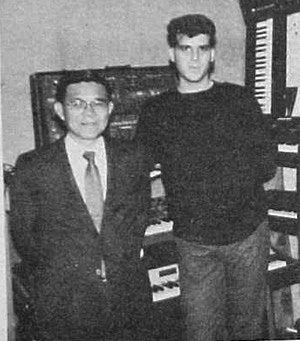 President of Yamaha – Mr. Masazumi Miyake and Unique Studio Manager Curt Cosentino cica 1983 |
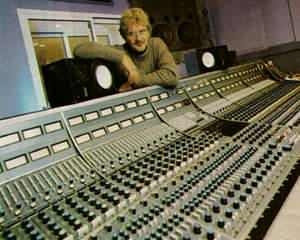 Jack Douglas behind the dual Neve 8068 Studio D – Unique Recording Studios |
Midi Recording Studio, “Midi City” Midi City was a recording studio We had tons of synthesizers, sequencers, drum |
|
on the music scene. With it’s built in graphic display it became the favorite with musicians. Opcode invented the Midi Interface for the Mac. Midi recording was now getting a foothold. We were Development Consultants for the first Macintosh Midi sequencers by Dave Oppenheim from Opcode Systems, Roy Groth from Mark of the Unicorn, and Bill Southworth from Southworth (Total Recall) |
 |
 Will Lee and Stevie Ray Vaughn |
(Public Access Synthesizer School). Everyone wanted to know what MIDI was and how to use it. My comparison of MIDI sequencers to a tape machine and mixing console helped many. Some of my favorite students were: Will Lee (The Late Show Band), Gary Rottger and Holly Goldrich (Manny’s Music). |
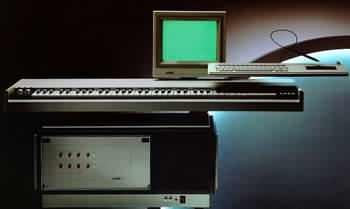 The Fairlight III |
I was finally offered a Fairlight III at a price that we could afford. Stuart Copeland made Midi City his home and recorded the soundtrack to all of ” The Equalizer” television shows. Herbie Hancock used our Fairlight III whenever he was in NYC. |
|
but luckily we never did! The next wave of lower priced affordable samplers killed the big high end units. |
 The Synclavier |
 The Drumulator |
for EMU’s The Drumulator. These rock drum sounds became a staple for the recording industry – most notable on “Tear For Fears” debut albumn. The creator’s of The Drumulator, |
|
was another synthesizer and sampler from Germany. We had the first one in NYC and I made samples for it as well. The sampler part never caught on but the synthesizer had great sounds. Programming ithe PPG left everyone totally lost. |
 The PPG Wave 2.2 |
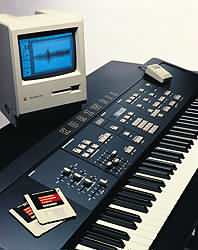 The Kurzweil 250 |
at the 1985 NAMM show, we purchased one of the first Kurzweil 250s for Unique Recording. Sampling with mac interface was really painfull. The sounds never compared to Ray Kurzweil’s internal sampled piano sound. Clients used the K250 until Roland’s MKS20 low priced piano module changed all that. |
|
did not have midi , it’s sampler was triggerable from tape. It changed mixing forever. The Lord Alge brothers and Bob Rosa were among the engineers that used the AMS samplers to change the sound of Kick and Snare. This can be heard on the remix of Bruce Springsteins “Dancin’ In The Dark”. |
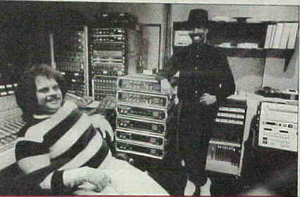 Engineer Bob Rosa & Producer Keith Diamond Studio B -Unique Recording circa 1984 with 4 AMS DMX 1580s delays |
|
the AMS. It had full bandwidth stereo sampling, riggerable inputs from tape and the best pitch shifting computer for it’s time period. |
 The Publison Infernal 90 Sampler |
 The Linn 9000 |
for Roger Linn’s Linn 9000. We tried our hardest to perfect it. It had it’s downfalls but it was the new workhorse. I was again busy making samples for the Linn 9000 and perfecting the internal sequencer. |
|
to help with another new sampler. It was actually made up of eight memory man delay pedals with Midi. It was the Akai S900. I made samples for the S900 as well. The S900 was the first affordable sampler with 8 triggerable inputs that worked from Simmons drum pads as well as tape |
 Akai S900 Sampler |
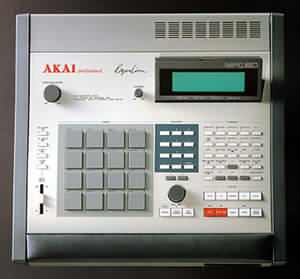 Akai MPC-60 |
Akai. With Akai’s backing it became the MPC60 and finally MPC3000 and MPC2000. |
|
we had the early prototypes to use at Unique. Emu’s SP1200 became the “Rap” machine. It looped and locked to tape flawlessly. |
 Emu SP1200 |
 Korg M1 |
Programmers camme to make their sounds.. I hired Jack Hotop to run this room. He eventually went to Korg, where he programed the sounds of the Poly Six, M1, SG1 and O1W. He passed on an touring offer as keyboard player for the band Yes for this gig. Two other programmers that made this room their home were Dr.Bob Khozouri and Billy Cobin aka Billy James. |
When Steve Winwood came and saw this room he was
like a kid in a candy store.
It led to recording his 1986 “Back In The High
Life” Lp.
with producer Russ Titleman at Unique Recording
Studios.